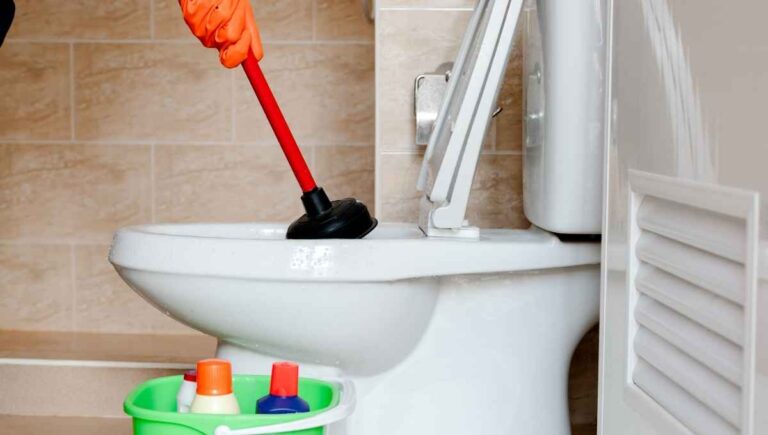Where Do Bathroom Fans Vent To? (Knowing This Is Important)

Bathroom fans are essential fixtures in any bathroom, but many people are unaware of where they vent to. Knowing where your bathroom fan vents is important for several reasons, including ensuring proper ventilation and preventing mold growth.
On average, most bathroom fans are vented to the outside of the home. This is because venting to the outside provides the most effective means of removing moisture and odors from the bathroom. Additionally, venting to the outside helps to prevent mold growth and improve indoor air quality.
In this article, we’ll discuss why your bathroom vent should not vent into the attic and what are the building codes regarding bathroom ventilation. We also give you a step-by-step guide on how to vent your exhaust fan through the eave of your house.
This post contains affiliate links. This means Household Blogger may earn a commission should you make a purchase using any of our links. Please refer to our full affiliate disclosure policy for full details.
Here’s a Quick Pro Tip!
Installing a duct to properly vent your exhaust fan might seem like a daunting task, but luckily we provide you with a step-by-step tutorial in this article and we also have a few recommendations to make the process easier!
Our must-haves essentials for installing an exhaust fan vent:
1. An eave/soffit vent kit – To protect the outlet of your duct against weather and the elements.
2. Damper – Used in an apartment to block the smells of other units trailing into your unit.
3. Aluminum Duct – To vent the air from the august fan to the outlet outside of the home.
Where Should the Bathroom Air Go?
The moist air in your bathroom needs to be removed to prevent mold from flourishing. This is done by installing an exhaust fan to vent your moisture to the outside of the house.
Where Should a Bathroom Fan Vent To?
A bathroom extractor fan vent removes the humidity and moisture from the air and should vent out of the house, not to the attic as it does in some houses, which could cause some trouble.
The moisture that gets extracted needs to go somewhere, and it is not recommended to vent it into your attic. The moisture only travels to a different area (the attic) and mold and mildew will start to grow.
Do Bathroom Fans Always Vent Outside?
In some houses, bathroom fans vent to the attic, although this is not recommended. Your bathroom fan should always vent the moisture out of the house, mostly through ventilation ducts outside the house.
If bathroom fans vent into the bathroom moisture will start to precipitate in your attic, mostly since your attic is not insulated like the rest of the house. Over time your wood rafters will rot and mold will flourish in your attic.
Where Does the Bathroom Vent Lead To?
The bathroom vent is supposed to vent outside, but sometimes builders don’t do this. You should be able to see the outdoor vent on the side of your house or see the wind blowing out of your roof.
If you suspect that your extractor does not vent outside your house, you should contact a carpenter to check and correct the problem. This is not something that you should ignore, as improper venting could lead to health or even safety risks.
If your extractor vents into your attic, mold, and mildew will start to grow in your attic. This could lead to respiratory issues and if ignored for a prolonged period it could even cause your wood beams to rot and your roof collapsing.
Do Bathroom Fans Vent Outside?
Bathroom fans vent to the outside of your house, either to a wall vent outlet or to the roof. These vent outlets should be easy to spot on your wall or roof. You should also be able to see the air being extracted when the fan is on.
If your bathroom extractor fan vents to a crawl space or the attic, you should contact a carpenter to correctly vent your bathroom fan. Your attic or crawlspace is not designed to handle that much moisture.
Do Bathroom Fans Only Vent to the Attic?
Bathroom fans should typically not vent to the attic, this causes mold to grow in your insulation and your roof will begin to rot. According to the Environmental Protection Agency, bathroom fans should be vented to the outdoors.
This building code by the EPA for the state of Virginia states that all exhaust fans (bathroom and kitchen) should be vented to the outdoors. However, every state has different building codes. Therefore, you should check your specific state’s building code.
You might also enjoy our post on If Bathroom Fans Remove Smells
Bathroom Fan That Doesn’t Vent Outside?
For a bathroom exhaust fan to extract the moisture out of your bathroom, it has to vent outdoors. There are ductless bathroom fans but these do not extract moisture, it only controls the odor of your bathroom.
In accordance with the International Residential Code (IRC) section M1502, the air exhausted from your bathroom should not be exhausted into an attic, soffit, ridge vent, or crawl space. It can be damaging to the structure of your home.
Where Do Bathroom Fans Vent to in Apartments?
In most states, apartment bathrooms are required to vent to the outside of the building. This can be checked in your local building codes. Although each individual apartment does not have its own outlet, apartments usually share a common ventilation shaft.
The apartments are separated by dampers, which will not allow air to travel between apartments, so your neighbor’s moist bathroom air does not travel into your apartment. If you notice odd smells coming from your vents you could replace the damper.
Do Bathroom Vents in Apartments Go Outside?
In apartments, the bathroom exhaust fan should also vent to the outside of the building. In most cases, the apartment’s vents are connected via a shared ventilation shaft that vents out on the roof of the building.
Most apartment buildings have HVAC systems that run through the entire building and regulate the intake and distribution of air. You should not place furniture directly in front of an air vent as this hinders the proper ventilation of your unit.
How to Properly Vent a Bathroom Fan.
Knowing where and why the air needs to be vented helps, but now let’s discuss how to tell if your bathroom needs a vent and how to install one.
How to Tell if a Bathroom Fan Is Vented
The easiest way to tell if your bathroom fan is vented to the outside of your house is to check for a vent hood on the outside of your house. This is commonly found on the wall or the roof.
Next thing is to turn on the fan and check if the vent hood opens and releases this air. If you turn on your fan but the air is not venting to the outside it could be venting to your attic. You should check that your vent pipes are straight and connected.
How to Vent a Bathroom Fan
There are three ways to vent a bathroom fan. Through the eave of your roof is the most popular and the easiest. The sidewall is also popular but not really aesthetically pleasing. Through the roof is absolutely possible but it’s not easy and can cause problems if you live in a snowy area.
How to Vent a bathroom fan through the eave:
- Measure your bathroom fan and cut a hole in the roof of the same size.
- Install the ceiling fan and attach a flexible duct to one end.
- Your pipe will be going through the attic so you need to make sure it is sealed completely with duct tape or zip tie. You should also insulate your pipe.
- Now one end is connected to the bathroom fan and the other you should place where you want it to vent outside.
- Go outside and cut a hole in your eave where you would like the air to vent, make sure the hole is big enough for the pipe to fit through.
- Purchase an eave vent kit from Amazon or your local hardware store.
- Stand on the outside and pull your flexible duct through the hole in your eave and cut it. It should be long enough to connect it with the 3-inch or 4-inch pipe, included in your eave vent kit, and still be straight inside your attic.
- Connect your duct and pipe and seal it with sheet metal tape.
- Cover the pipe with the vent cover and attach the cover to yours with rust-resistant screws.
- Turn on your bathroom fan and check that air is blowing out through your duct pipe and eave cover.
How Do You Vent a Bathroom With No Outside Access?
Sometimes a bathroom does not have outside access, but that is not an excuse to simply leave the bathroom as-is. All bathrooms should have proper ventilation. The best option is to vent your bathroom with no outside access is a ceiling vent.
These are similar to exhaust fans except they do not ventilate the moisture outdoors. Most times the moisture gets blown into the attic. These fans can be effective in removing moisture from your bathroom.
How Do I Vent a Bathroom Fan to the Side Wall?
Venting a bathroom fan through the sidewall is a popular option, although some might think it is not attractive to have a vent cover on the side of your house. The process is almost exactly the same as our steps to vent through your eave mentioned above.
The only real difference is making a hole in the side of your house and not through the eave. An extra addition could be adding a layer of silicone beading around the outside vent to prevent water from seeping in when it is raining.
Building Codes That You Should be Aware of
Great, you know why, where, and why! What about building codes? Are you legally required to have a vent in your bathroom, short answer: maybe.
Is It Ok to Vent the Bathroom Fan Into the Soffit?
In accordance with the International Residential Code (IRC), your bathroom fan should not vent into the soffit or attic. Although it is allowed to vent through the soffit to the outside of the house.
The IRC does not recommend this due to the soffit not being designed to handle large amounts of moisture and humidity. You will see mold growing in your soffit and this could lead to structural damage to your roof and eaves.
Is It Better to Vent the Bathroom Fan Through the Roof or Soffit?
Both are valid choices and one option is not clearly better than the other, however, roof vents might be blocked frequently due to snow. This is not a massive problem as the snow will probably melt when moisture rises through the vent.
In terms of installation, venting your bathroom through your soffit would be the easier solution. This is because it is extremely difficult to get on your roof and drill a hole on uneven roof tiles. It is not impossible though!
You might also enjoy our post on If Bathroom Lights Need to be GFCI Protected?
What Is Code for Venting a Bathroom Fan?
Each state has its own building code pertaining to information about the venting of your bathroom fan. Most often a full bathroom, i.e. bath, shower, sink and toilet needs to have an exhaust fan that vents to the outside.
The IRC also states that vents may not blow out into the attic or crawlspace. These areas are typically not insulated and also not manufactured for that much moisture. Your vent should lead to the outside through your roof, soffit, or sidewall.
Can You Vent a Bathroom Fan Through the Side of the House?
You can vent a bathroom fan through the side of your house. It is quite a big project to undergo so if you are not typically a handy person we recommend contacting a carpenter to correctly vent your bathroom fan.
You can follow our step-by-step guide for installing an extractor fan through the soffit, simply lead it to your sidewall instead of the soffit. The other steps are easy to follow and will show you how to vent a bathroom fan.
Can a Bathroom Fan Be Installed in the Wall?
A bathroom exhaust fan can be installed on the wall and it can vent directly out with a through-the-wall vent. This is only possible if your bathroom has a wall that faces the outdoors.
If you are installing this bathroom fan on your bathroom wall, make sure that the exhaust fan is exactly behind the duct that leads outside. These options are definitely the easiest but sometimes it’s a bigger task than you think, especially if you have a brick wall.
Vent Types
There are so many different types of vents and fans, each with its own purpose, advantages, and disadvantages.
Can You Put a Normal Fan in the Bathroom?
A normal fan will not ventilate or extract the moisture from your bathroom. So it’s not an ideal choice for the bathroom. Mold and mildew will grow in your bathroom if your only fan is normal.
A normal fan simply circulates the air that is already in your bathroom, however, it is better than nothing. If your bathroom has no vent or the electricity costs are too much for you an open window and normal fan would do the trick.
What Is the Difference Between Electric Fans and Exhaust Fans?
The biggest difference between an electric fan and an exhaust fan is their purpose. An electric fan is used to simply circulate the air, while an exhaust fan is mainly used to extract moisture, smoke, and odors from the air.
Electric fans are used in any room in the house, usually as ceiling fans or portable fans. An exhaust fan is found in the bathroom or kitchen to extract moisture and prevent mold and mildew from growing. Exhaust fans have a vent that blows the air to the outside.
What Do You Do if Your Bathroom Doesn’t Have a Vent?
If your bathroom does not have a vent you should keep your windows and doors open when showering, or even at all hours. This allows the air to naturally ventilate out of your bathroom.
If the weather does not permit an open window, keep your door open – even just a crack while showering and wide open when you’re finished. The best option is to call a carpenter and install a bathroom exhaust vent.
How Do You Vent a Small Bathroom?
No matter the size of your bathroom, it needs an exhaust fan. Even if your bathroom is small, you should install an exhaust fan. If your bathroom is a half bathroom (only a toilet and sink) leaving the window open would suffice enough ventilation.
Another option for venting a small bathroom is leaving a window open, especially while showering or bathing. This acts as natural ventilation, but an exhaust fan still works the best to ventilate a small bathroom.
What Is the Best Way to Ventilate a Bathroom?
There are two main ways to ventilate a bathroom. The best is to install an exhaust fan. The other option is ‘natural’ ventilation, i.e. leaving the door or window open while showering.
Mold and mildew love to grow across your bathroom surfaces, and the extractor fan can immediately ventilate the moisture out of the bathroom to prevent that from happening. Open windows or doors are not as accurate.
How Do I Vent a Bathroom With No Windows?
According to the EPA, your bathroom should have a window that can open or an exhaust fan that can provide at least 50 cfm (cubic feet per minute) and that ventilates to the outdoors.
This building code, specifically for Virginia, is similar in most states, but some do differ. So, we recommend checking your local state building code regarding ventilation in a bathroom with no window.
Is It Okay to Have a Bathroom Without a Vent?
If your bathroom has a window that can open, then it is not required to install a vent. However, if your bathroom has no window you are required to install an exhaust fan and vent the moisture out of your bathroom.
We recommend installing an exhaust fan that vents to the outside even if you have a window in your bathroom. The fan is much more effective in preventing health risks from mold and mildew growing in your bathroom.
What Is the Point of a Ductless Bathroom Fan?
A ductless fan circulates the air in the bathroom to remove moisture and odor. These fans do not have an outside vent as they do not extract the moisture, but the air passes through a filter that draws the moisture from the air.
These fans are popular in rooms and homes where ductwork is not possible, like an apartment or a basement. Ductless fans include online fans that are mounted in the wall or roof space and they are a lot easier to install than a duct exhaust vent.
Related Questions
Does a Bathroom Exhaust Fan Need to Be Insulated?
A bathroom exhaust fan and duct should always be insulated. This prevents mold, condensation, and water damage to your fan. The best way to insulate the fan is to cover the fan with an airtight box.
The box can be made from rigid foam and the seams taped with duct tape. Another insulation method is to use sealing foam around the box and drywall to insulate the box and exhaust pipe.
Do Bathroom Fans Remove Smell?
Bathroom fans absolutely help to dissipate any odors that might be lingering in your bathroom. Although, their primary function is extracting the moisture from the air of your bathroom.
Keeping the air of your bathroom fresh and removing any odors really makes your bathroom feel ‘clean’. These fans work exceptionally well for homes where big families use the same bathroom.
Is It Okay to Have a Bathroom Without a Window?
If your bathroom does not have a window it should 100% have an exhaust vent. There needs to be some way of extracting the moisture from the air in your bathroom, either through an open window or an exhaust vent.
If you have no window or exhaust fan in your bathroom, mold and mildew will start to grow in your bathroom. Mold can cause respiratory health issues and it can also cause structural damage to your bathroom.
Can You Use a Regular Fan as an Exhaust Fan?
A regular fan does not do the same work as an exhaust fan. A regular fan circulates the air that is in the room while an exhaust fan extracts the moisture from the air and vents it to the outside of the house.
If your bathroom has a window, leaving it open while a regular fan is blowing could help to ventilate the moisture in your bathroom. It might also help to reduce any odors that might be in your bathroom.
Final Thoughts
You made it to the end! By now you should realize that having a bathroom vent is crucial to the safety and health of your family. A cracked window and an open door can also do the job, just not as thoroughly. If your bathroom does not have an exhaust fan, it might be time to invest in one!










